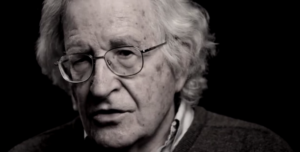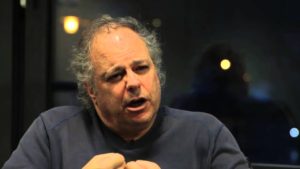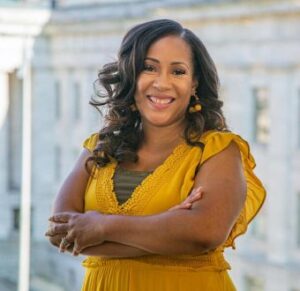Chomsky: US Policy Toward Russia Is Blocking Paths To De-Escalation In Ukraine
Russia’s war in Ukraine is producing an earthquake in international affairs. The war has raised new questions about national security across Europe and is shaking up energy geopolitics. In addition, the war seems to be creating new divisions between the Global North and the Global South while Russia and China strengthen their strategic relationship.
In the interview that follows, world-renowned scholar and leading dissident Noam Chomsky addresses some of the new developments taking place in the world system on account of Russia’s assault on Ukraine. Chomsky also ponders the question of whether Vladimir Putin can be prosecuted for war crimes in light of the mounting evidence that brings to mind the atrocities committed by the Nazis during World War II. Recent evidence also indicates that Ukrainian forces have also engaged in war crimes by killing captured Russian soldiers.
Chomsky, who is internationally recognized as one of the most important intellectuals alive, is the author of some 150 books and the recipient of scores of highly prestigious awards, including the Sydney Peace Prize and the Kyoto Prize (Japan’s equivalent of the Nobel Prize), and of dozens of honorary doctorate degrees from the world’s most renowned universities. Chomsky is Institute Professor Emeritus at MIT and currently Laureate Professor at the University of Arizona.
C. J. Polychroniou: The war in Ukraine has turned Russia into a pariah state throughout Europe and North America, but Moscow continues to receive support from many countries in the Global South. The strategic relationship between Russia and China seems to be getting stronger, although both countries had identified each other as major factors for maintaining order and stability in an “emerging polycentric world” long before Putin and Xi Jinping. In fact, Russian Foreign Minister Sergey Lavrov said following a recent meeting with his Chinese counterpart that the two countries are working together to advance a vision of a new world order, a new “democratic world order.” Is the new world order one that pits Global North and Global South countries against each other? And what do you make of the statement of Russia and China working together to promote a new “democratic world order?” To me, the idea of two autocratic states working together to promote democracy across the world sounds like a crude joke.
Noam Chomsky: The idea that Russia and China will be working together to promote a “democratic world order” is, of course, ludicrous. They will be doing so in much the way that the U.S. was laboring to “promote democracy” in Iraq, the goal of the invasion as President Bush announced when it became clear that the “single question” — will Saddam abandon his nuclear weapons program? — had been answered the wrong way. With rare exceptions, the intellectual class and even most scholarship leaped to attention and vigorously proclaimed the new doctrine, as I suppose is also the case today in Russia and China.
As U.S.-run polls showed, Americans enthralled by the “noble” goals belatedly proclaimed were even joined by some Iraqis: 1 percent of those polled. Four percent thought the U.S. invaded in order to help Iraqis. The rest concluded that if Iraq’s exports had been asparagus and pickles, and the center of global petroleum production was in the South Pacific, the U.S. wouldn’t have invaded.
I don’t pretend to have any expert knowledge, but from my own experience in past weeks with the Global South — press, many interviews and meetings, much personal discussion — it doesn’t seem to me quite accurate to say that it is supporting Moscow, except in the sense that Moscow is getting support from the Western powers that keep paying it for petroleum products and food (probably by now the source of Russia’s main export earnings).
My impression is that the Global South has sharply condemned the Russian invasion, but has asked: “What’s new?” The general reaction to President Biden’s harsh condemnation of Putin as a war criminal seems to be something like this: It takes one to know one. We agree that he is a war criminal, and as creatures of the Enlightenment, we adopt the Kantian principle of universality that is dismissed with contempt by the West, sometimes with angry charges of whataboutism.
It is, after all, not easy for people in the civilized world — increasingly, the Global South — to be impressed by the “moral outrage” of Western intellectuals who just a few years ago, when all the horrific facts were in, were enthusiastically applauding the success of the invasion of Iraq, spouting pieties about noble intentions that would have embarrassed the most abject apparatchik. And we can just imagine the reaction when they read the pious invocation of the Nuremberg judgment by the editors of The New York Times, who are just now coming to recognize that, “To initiate a war of aggression, therefore, is not only an international crime: it is the supreme international crime, differing only from other war crimes in that it contains within itself the accumulated evil of the whole.” The accumulated evil includes the instigation of ethnic conflict that has torn apart not only Iraq but the whole region, the horrors of ISIS, and much more.
Not, of course, what the editors have in mind. The supreme international crimes that they have supported for 60 years somehow escaped the Nuremberg judgment.
While there is appreciation in the Global South for the fact that at long last Western intellectuals and the political class are coming to perceive that aggressors can commit hideous crimes, they seem to feel that it is perhaps a little late, and curiously skewed, as they know from ample experience. They are also able to perceive that Westerners consumed with moral outrage over the crimes of enemies are still able to maintain their usual silence while their own leaders carry out terrible crimes right now — in Afghanistan, Yemen, Palestine, Western Sahara, and all too many other places where they could act at once, and expeditiously, to mitigate or end these crimes.
Let’s turn to the “strategic relationship between Russia and China.” It does indeed seem to be strengthening, though it is not much of a partnership. The corrupt Russian kleptocracy can provide raw materials and advanced weapons to the economic system that Beijing is systematically establishing through mainland Asia, reaching also to Africa and the Middle East, and by now even to U.S. domains in Latin America. But not much more. Russia’s role in this highly unequal relationship is, I think, likely to diminish further, much as Europe’s international role is likely to diminish after Putin has handed Europe on a golden platter to the U.S.-run “Atlanticist” system, a gift of substantial significance, as we’ve discussed before.
Can China help end the war in Ukraine? If yes, what’s stopping Beijing from using its influence over Moscow for a peace agreement to be reached in Ukraine?
China could act to advance the prospects for a peaceful negotiated settlement in Ukraine. It seems that the Chinese leadership sees no advantage in doing so.
China’s “information system” appears to be pretty much conforming to the Russian propaganda line. But more generally, it doesn’t seem to diverge much from a fairly common stance in the Global South, illustrated graphically by the sanctions map. The states joining in sanctions against Russia are in the Anglosphere and Europe, as well as Japan, Taiwan and South Korea. The rest of the world condemns the invasion, but is mostly standing aloof.
This should not surprise us. It is nothing new. We recall well that the Iraq invasion had virtually no global support. Less familiar is the fact that the same was true of the U.S. invasion of Afghanistan after 9/11. A few weeks after the invasion, an international Gallup poll asked the question: “Once the identity of the [9/11] terrorists is known, should the American government launch a military attack on the country or countries where the terrorists are based or should the American government seek to extradite the terrorists to stand trial?”
The wording reflects the fact that their identity was not known. Even eight months later, in his first major press conference, FBI Director Robert Mueller could only affirm that al-Qaeda was suspected of the crime. If the poll had asked about actual U.S. policy, the very limited support would doubtless have been even lower.
World opinion overwhelmingly favored diplomatic-judicial measures over military action. Opposition to invasion was particularly strong in Latin America, which has a little experience with U.S. intervention.
The free press spared Americans knowledge of international opinion. It was therefore able to proclaim that “the opposition [to the U.S. invasion] was mostly limited to the people who are reflexively against the American use of power.”
Quite a few suffer from this malady, apparently. Global opinion today should come as no great surprise.
China’s unwillingness to devote its efforts to a negotiated settlement of the Ukraine conflict deserves criticism, but it is hard to see how such criticism can properly come from Americans. After all, China is adhering to official U.S. policy. Simply put, the policy is to “fight to the last Ukrainian for Ukrainian independence” while offering no way to save Ukraine from further tragedy. Even worse, current policy undermines such hopes by informing Putin that he has no way out: It’s The Hague or proceed to destroy Ukraine.
The quote and the opinions just paraphrased are those of one of the most astute and widely respected U.S. diplomats, Ambassador Chas Freeman, who goes on to spell out the options, and to remind us of the history.
Like anyone who cares in the least about the fate of Ukrainians, Ambassador Freeman recognizes that the only alternative to Russian destruction of Ukraine — which, with their backs to the wall, Putin and his narrow circle of siloviki can implement — is a negotiated settlement that will be ugly, offering the aggressors an escape. He also carries the history back further than we have done in our earlier discussions, back to the Congress of Vienna of 1814, which followed the Napoleonic Wars. Metternich and other European leaders, he observes, “had the good sense to reincorporate [defeated] France into the governing councils of Europe,” overlooking its virtual conquest of Europe. That led to a century of substantial peace in Europe, which had long been the most violent part of the world. There were some wars, but nothing like what preceded. The century of peace ended with World War I.
Freeman goes on to remind us that the victors in the war did not have the good sense of their predecessors: “The victors — the United States and Britain and France — insisted on excluding Germany from a role in the affairs of Europe, as well as this newly formed Soviet Union, the result was World War II and the Cold War.”
As we’ve discussed earlier, a leading theme throughout the Cold War was the status of Europe: Should it subordinate itself to the U.S. within the Atlanticist-NATO framework, the U.S. preference? Or should it become an independent “third force” along Gaullist lines, accommodating Russia within a Europe without military alliances from the Atlantic to the Urals?
The question arose starkly when the USSR collapsed, and Mikhail Gorbachev outlined the vision of a “common European home” with no military alliances from Lisbon to Vladivostok. In a limited form, the concept was revived by French President Emmanuel Macron in his recent abortive interchanges with Putin.
If there had been anyone in the Kremlin who resembled a statesman, they would have leaped at the opportunity to explore something like the Gorbachev vision. Europe has strong reasons to establish close relations with Russia, ranging from commerce to security. Whether such efforts might have succeeded, avoiding the Ukraine tragedy, we can only guess. The answer could only have been found out by trying. Instead, the hard men in Moscow turned to violence, compounding their criminal aggression with self-defeating foolishness.
The Gorbachev conception had some partial U.S. support within the framework of the Partnership for Peace, a U.S. initiative intended to provide a cooperative security system with a limited relation to NATO. Ambassador Freeman, who had a significant role in establishing it, describes its fate in words that are worth heeding:
What happened in 1994, which was a midterm election year, and 1996, which was a presidential election year, was interesting. In 1994, Mr. Clinton was talking out of both sides of his mouth. He was telling the Russians that we were in no rush to add members to NATO, and that our preferred path was the Partnership for Peace. The same time he was hinting to the ethnic diasporas of Russophobic countries in Eastern Europe — and, by the way, it’s easy to understand their Russophobia given their history — that, no, no, we were going to get these countries into NATO as fast as possible. And in 1996 he made that pledge explicit. [In] 1994 he got an outburst from [Boris] Yeltsin, who was then the president of the Russian Federation. [In] 1996 he got another one, and as time went on, when Mr. Putin came in, he regularly protested the enlargement of NATO in ways that disregarded Russia’s self-defense interests. So, there should have been no surprise about this. For 28 years Russia has been warning that at some point it would snap, and it has, and it has done it in a very destructive way, both in terms of its own interests and in terms of the broader prospects for peace in Europe.
None of this provides any excuse for Putin’s invasion, Freeman emphasizes. But it is important to understand that, “There were those people in the United States who were triumphalist about the end of the Cold War…. This allowed the United States to incorporate all the countries right up to Russia’s borders and beyond them, beyond those borders in the Baltics, into an American sphere of influence. And, essentially, they posited a global sphere of influence for the United States modeled on the Monroe Doctrine. And that’s pretty much what we have.”
Russian leadership tolerated Clinton’s violation of the firm U.S. commitment to Gorbachev not to extend NATO beyond East Germany. They even tolerated George W. Bush’s further provocations, and U.S. military actions that struck directly at Russian interests, undertaken in such a way as to humiliate Russia. But Ukraine and Georgia were red lines. That was clearly understood in Washington. As Freeman continues, no Russian leader was likely to tolerate the NATO expansion into Ukraine that began after the 2014 “coup, [carried out] to prevent neutrality or a pro-Russian government in Kiev, and to replace it with a pro-American government that would bring Ukraine into our sphere…. So, since about 2015 the United States has been arming, training Ukrainians against Russia,” effectively treating Ukraine “as an extension of NATO.”
As we’ve discussed, that stance became explicit policy in Biden’s September 2021 official statement, possibly a factor in Russia’s decision to escalate to direct aggression a few months later.
Crucially, to repeat, current U.S. policy is to “fight to the last Ukrainian” while offering no way to save Ukraine from further tragedy and in fact undermining such hopes by informing Putin that he has no way out: It’s The Hague or proceed to destroy Ukraine.
China is probably relatively satisfied with the course of events. Very likely the same is true in Washington. Both have gained from the tragedy. And the euphoria among weapons and fossil fuel producers is unconcealed as they lead the way toward indescribable catastrophe, underscored in vivid terms by the Intergovernmental Panel on Climate Change report of April 4.
Turkey’s position over the war in Ukraine is to maintain neutrality while acting as a mediator in the Russian-Ukrainian crisis. Can Turkey continue to maintain such a balancing act since we know that it has been supplying military assistance to Ukraine since 2019 and that it is aligned with the geo-strategic vision of Washington over Ukraine?
Turkey has had an ambiguous position in global affairs for many years. It is a member of NATO, but the EU has rejected its appeals for membership on human rights grounds. In the 1990s, Turkey was indeed responsible for hideous crimes: its massive state terror against its Kurdish population, leaving tens of thousands dead, 3,500 towns and villages destroyed, a flood of hundreds of thousands of people from the devastated Kurdish regions to miserable slums in Istanbul. The crimes were mostly concealed by the “free press,” perhaps because Clinton was pouring arms into Turkey, the flow escalating as atrocities mounted. Turkey became the leading recipient of U.S. military aid (apart from Israel-Egypt, a separate category), extending a very close correlation between human rights abuses and U.S. aid that goes far back, but somehow does not detract from its much-lauded nobility.
By 2000, Turkish state crimes were abating, and in the following years the situation greatly improved — something I was able to witness personally, with much appreciation. By 2005, under President Recep Erdoğan’s increasingly harsh rule, the progress ended and reversed. That might have been in part a reaction to the continued refusal of the European Union to accept Turkish membership, ignoring the great steps forward in recent years and fortifying the sense that Europeans simply won’t accept Turks into their club.
Since then, Erdoğan’s rule has become far more brutal, again targeting Kurds but also attacking civil and human rights on a broad front. And he has been trying to turn Turkey into a major actor in regional affairs, with hints of a renewed Ottoman caliphate. He accepts Russian weapons over strong U.S. objections but remains a central part of the NATO system of regional — by now global — dominance. The “balancing act” with regard to Ukraine is a case in point.
If Turkey can facilitate negotiations that will bring the Ukraine horrors to an end, that will be a most welcome development, to be applauded. We can only speculate about what the chances are while the U.S. insists on perpetuating the conflict “to the last Ukrainian” while blocking an ugly negotiated settlement that is the alternative to destruction of Ukraine and perhaps even nuclear war.
Russian gas continues to flow to Europe although Putin had demanded that European governments pay for it in rubles. What would be the impact in the geo-strategic relations between Europe and Russia if the former became independent from Russian gas?
It doesn’t look likely in the near future. Europe could manage to end the use of Russian coal and oil, but gas is a different matter. That requires pipelines, which it would take years to build, or transport facilities for liquified natural gas that barely exist. But the question we should be asking I think is different. Can we ascend to the wisdom of the reactionary tyrants who provided Europe with a century of peace in Vienna in 1814? Can we move towards the Gorbachev vision of a European common home with no military alliances, a conception not too far from the U.S.-initiated Partnership for Peace that was undermined by President Clinton? Can some resemblance to statesmanship appear in today’s Russia? Such questions as these should, I think, be in the forefront of our thinking, and our active engagement in trying to influence discussion and debate, and policy choices.
Evidence of Russian war crimes is mounting. Can Putin be prosecuted for war crimes in Ukraine?
Prosecution for war crimes, in the real world, is “victor’s justice.” That was clear from the Nuremberg Tribunal and was not even concealed in the accompanying Tokyo Tribunal. At Nuremberg, saturation bombing of densely settled urban areas was excluded because it was a specialty of the Allies. German war criminals were exculpated if they could show that the Allies carried out the same crimes. In subsequent years, the Nuremberg principles were thrown out the window. They have only recently been discovered as a cudgel to beat official enemies.
There can be no thought of trying the U.S. for its many horrendous crimes. An effort was once made to bring the U.S. to justice for its war against Nicaragua. The U.S. responded to the International Court of Justice orders to end the crimes by sharply escalating them while the press dismissed the court as a “hostile forum” as shown by its daring to convict the U.S. (per The New York Times’s editors), following ample precedent.
Putin might be tried for crimes if he is overthrown within Russia and Russia can be treated as a defeated country. That is what the record indicates.
Imaginably, the world might rise to a level of civilization in which international law can be honored instead of righteously wielded against selected targets. We should never cease efforts to bring that about. In doing so, we should not succumb to the illusions fostered by the global doctrinal systems.
Copyright © Truthout. May not be reprinted without permission.
C.J. Polychroniou is a political scientist/political economist, author, and journalist who has taught and worked in numerous universities and research centers in Europe and the United States. Currently, his main research interests are in U.S. politics and the political economy of the United States, European economic integration, globalization, climate change and environmental economics, and the deconstruction of neoliberalism’s politico-economic project. He is a regular contributor to Truthout as well as a member of Truthout’s Public Intellectual Project. He has published scores of books and over 1,000 articles which have appeared in a variety of journals, magazines, newspapers and popular news websites. Many of his publications have been translated into a multitude of different languages, including Arabic, Chinese, Croatian, Dutch, French, German, Greek, Italian, Japanese, Portuguese, Russian, Spanish and Turkish. His latest books are Optimism Over Despair: Noam Chomsky On Capitalism, Empire, and Social Change (2017); Climate Crisis and the Global Green New Deal: The Political Economy of Saving the Planet (with Noam Chomsky and Robert Pollin as primary authors, 2020); The Precipice: Neoliberalism, the Pandemic, and the Urgent Need for Radical Change (an anthology of interviews with Noam Chomsky, 2021); and Economics and the Left: Interviews with Progressive Economists (2021).





